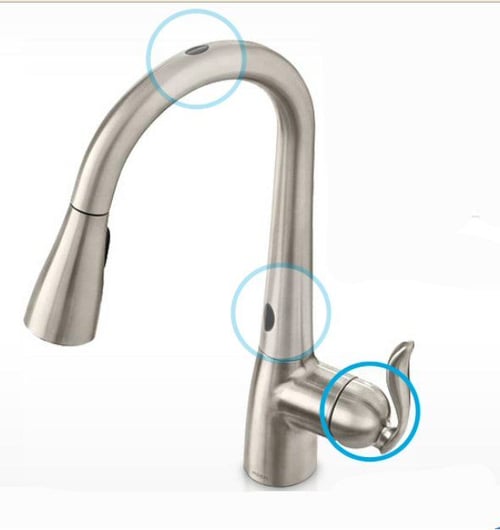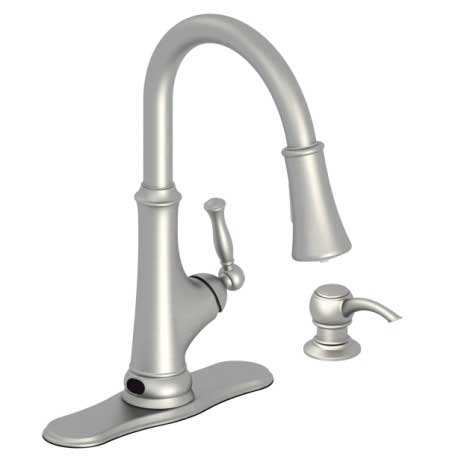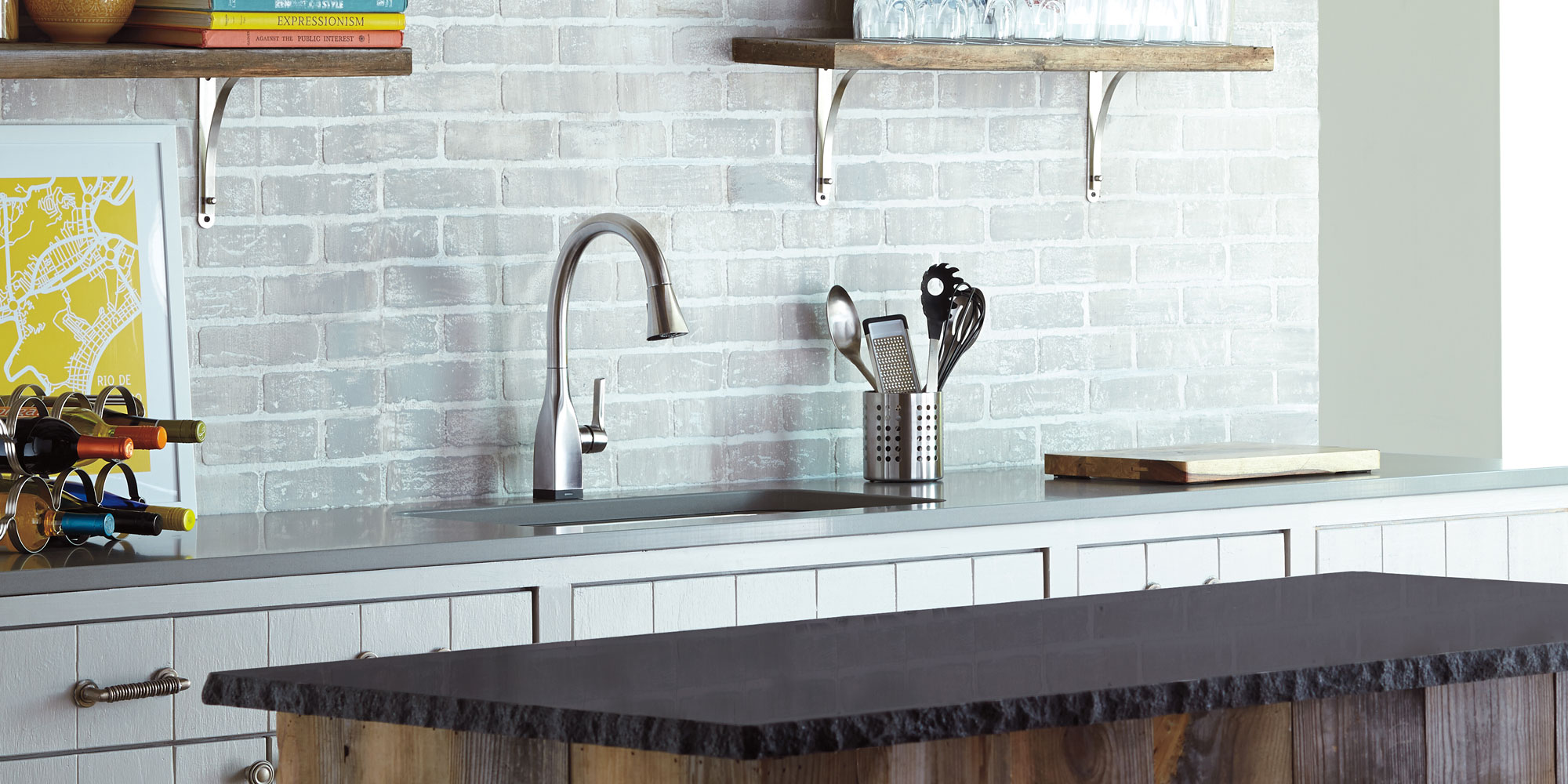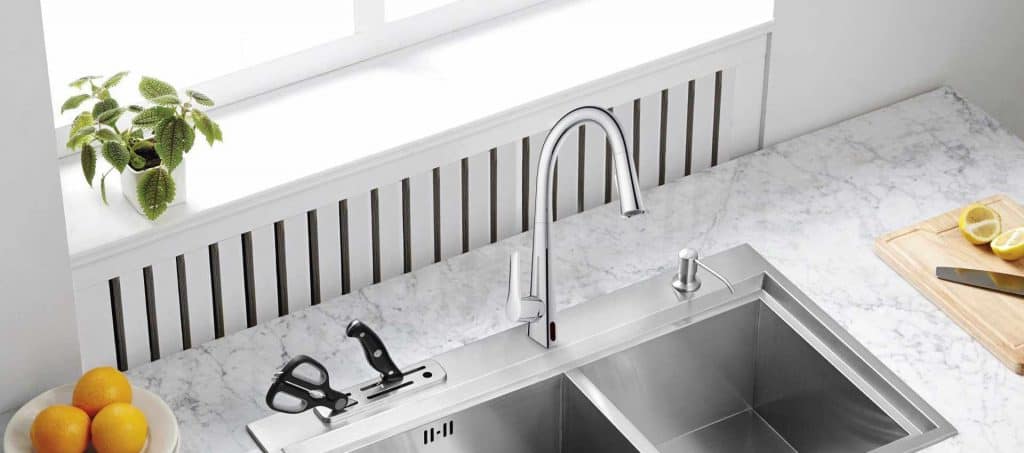A touchless kitchen faucet works by using motion sensors to detect the presence of a hand or object, which triggers the flow of water. This innovative technology allows users to turn the faucet on and off without physically touching it, providing convenience and promoting hygiene in the kitchen.
With a simple wave or gesture, the faucet recognizes the user’s intent and activates the water flow, making tasks such as washing dishes or filling pots easier and more efficient. By eliminating the need for manual operation, touchless kitchen faucets offer a modern and sanitary solution for homeowners seeking convenience and cleanliness in their kitchens.
Experience the future of kitchen technology with the touchless faucet revolution.

The Rise Of Touchless Technology
The rise of touchless technology has revolutionized the way we interact with everyday objects. From smartphones to smart homes, touchless technology has become increasingly prevalent in modern society. In the kitchen, touchless technology has made its mark through touchless kitchen faucets. These faucets are equipped with motion sensors that detect the presence of hands and activate the flow of water, providing a more hygienic and convenient solution for kitchen tasks. Touchless kitchen faucets also contribute to water conservation by allowing users to easily control the flow of water. With the integration of touchless technology in the kitchen, tasks such as washing dishes and food preparation have become more efficient and seamless.
Touchless Kitchen Faucets: A Primer
Touchless kitchen faucets work through motion sensors that detect hand movements. When a hand is placed under the faucet, the sensor triggers the water flow. This technology allows for hands-free operation, promoting hygiene and convenience in the kitchen. The appeal of touchless faucets lies in their ease of use and the reduction of germ transmission, making them a popular choice for modern kitchens.
Core Components Of Touchless Faucets
Touchless kitchen faucets use advanced technology to make your kitchen experience more hygienic and convenient. The key components of a touchless faucet are the sensors and the solenoid valve.
| Sensors | Solenoid Valve |
|---|---|
| The sensors are the eyes of the faucet, detecting motion and triggering the flow of water. They are usually located at the base or top of the faucet. | The solenoid valve controls the water flow and is activated by the sensors. It opens and closes the water supply based on the user’s movements. |
| Touchless faucets also have adjustable sensors that allow you to control the water temperature and flow rate. | The solenoid valve is a critical mechanism that ensures the faucet only dispenses water when needed, reducing waste and saving money on your water bill. |
Overall, touchless faucets are a great investment for any kitchen, providing improved hygiene, convenience, and water efficiency.

The Science Behind The Sensors
Touchless kitchen faucets are a marvel of modern technology, utilizing infrared sensors to detect the presence of a user. These sensors work by emitting an infrared beam that is reflected back to the sensor when an object, such as a hand, interrupts the beam. This interruption triggers the faucet to turn on or off, providing a seamless and convenient experience in the kitchen.
Infrared sensors used in touchless faucets require careful calibration and sensitivity adjustments to ensure accurate detection. This calibration process involves setting the appropriate range for detecting objects and adjusting the sensitivity of the sensor to avoid false triggers. By fine-tuning these settings, touchless faucets can accurately detect the presence of a user and respond accordingly.
The use of infrared sensors in touchless kitchen faucets not only provides a hands-free experience but also promotes hygiene by reducing the spread of germs and bacteria. With their advanced technology and sensor capabilities, touchless faucets are revolutionizing the way we interact with our kitchen fixtures.
Water Flow Control: How It Works
A touchless kitchen faucet works by utilizing motion sensors to detect movement, allowing for hands-free operation. When the user’s hand is within range, the sensor triggers the flow of water, providing a convenient and hygienic solution for kitchen tasks. Once the hand is removed, the flow of water is automatically deactivated, helping to conserve water and minimize wastage.
Temperature control in touchless systems is achieved through the integration of thermostatic technology, ensuring that the water temperature remains consistent for comfortable and efficient use. This feature enhances user experience and provides added convenience in the kitchen.

Powering Touchless Faucets
Touchless kitchen faucets can be powered either by batteries or by AC power. Battery-operated touchless faucets are convenient as they do not require any electrical connection. They typically use AA or AAA batteries, providing a reliable power source. On the other hand, touchless faucets powered by AC power require a direct electrical connection. They are usually connected to a power outlet under the sink or through hardwiring.
When it comes to energy efficiency and sustainability, battery-operated touchless faucets are a popular choice. They tend to have a longer battery life and can last for several months before needing replacement. Additionally, they are more environmentally friendly as they do not require constant electricity consumption. AC-powered touchless faucets, although convenient in terms of continuous power supply, may consume more energy in the long run.
Installation And Maintenance
Installing a touchless kitchen faucet can be done DIY or by a professional plumber. Professional installation ensures proper setup and functionality. For maintenance, regularly clean the faucet sensor and change batteries as needed. Avoid using harsh chemicals that may damage the sensor. Periodically check for leaks and tighten any loose connections to keep the faucet working efficiently. Consult the manufacturer’s guidelines for specific maintenance instructions.
Choosing The Right Touchless Faucet For Your Kitchen
When choosing a touchless kitchen faucet, consider features and finish options. Look for motion sensor accuracy and ease of installation. Top brands include Moen, Delta, and Kohler. Models like Moen Arbor and Delta Leland are popular choices. Factors to consider include water pressure requirements and battery life. Make sure the faucet fits your sink and matches your kitchen decor.
Frequently Asked Questions
How Does A Touchless Kitchen Faucet Work?
Touchless kitchen faucets use motion sensors to detect movement and turn the water on and off. When you place your hands under the faucet, the sensor sends a signal to the valve, which opens and allows water to flow. When you remove your hands, the sensor sends another signal to the valve, which closes and stops the flow of water.
How Do You Install A Touchless Kitchen Faucet?
Installing a touchless kitchen faucet is similar to installing a regular faucet, but you’ll need to connect the sensor and the valve to a power source. Most touchless faucets come with a battery pack or an AC adapter. Follow the manufacturer’s instructions for installation and wiring.
Are Touchless Kitchen Faucets More Hygienic?
Yes, touchless kitchen faucets are more hygienic than traditional faucets. Since you don’t need to touch the faucet handle to turn it on and off, you’ll reduce the spread of germs and bacteria. Touchless faucets also help to conserve water by reducing the amount of water wasted by leaving the faucet running while you’re washing your hands or dishes.
How Long Do The Batteries Last In A Touchless Kitchen Faucet?
The battery life of a touchless kitchen faucet varies depending on the brand and the type of batteries used. Most touchless faucets use AA or AAA batteries, which can last for up to two years with normal use. Some touchless faucets also have low battery indicators to let you know when it’s time to replace the batteries.
Conclusion
Touchless kitchen faucets use motion sensors to activate the water flow, enhancing convenience and hygiene. The technology offers a hands-free experience, conserves water, and adds a modern touch to any kitchen. With easy installation and user-friendly features, touchless faucets are a practical and stylish choice for any home.

